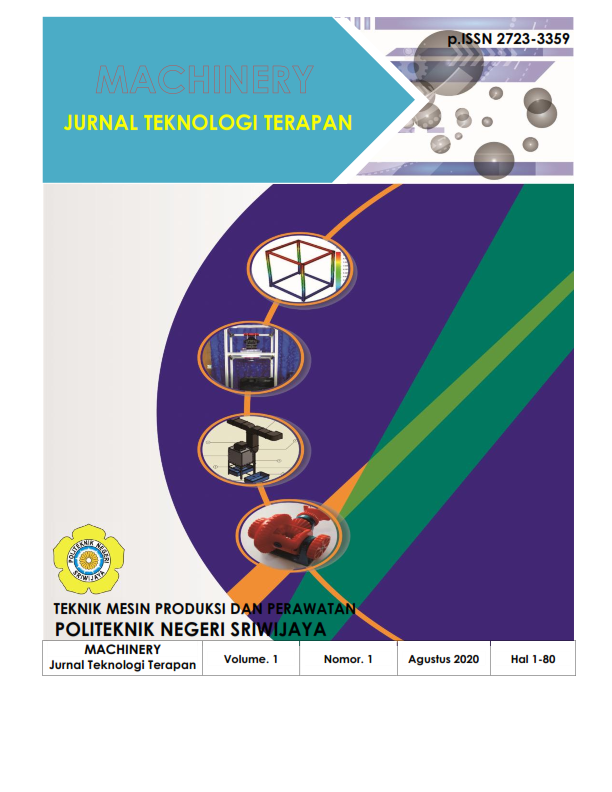STUDI PEMBUATAN BAGIAN ALAT REHABILITASI PENDERITA STROKE DENGAN PENDEKATAN METODE TAGUCHI
DOI:
https://doi.org/10.5281/zenodo.4540849Keywords:
Taguchi, Layer Height, Print Speed, Print Temperature, Dimensional Accuration, HardnessAbstract
3D Printer is a solution to fulfill product demand that is custom design and not necessarily mass production. However, as long as the printing process produces a product that is not the same as the design size and has a fragile structure, there is a small deviation of dimensional accuracy and hardness value. This research focuses on dimensional accuracy and hardness of 3D Printer prints by using the design of one of the components of stroke rehabilitation tools, It aims to find a printing parameter component of a stroke rehabilitation tool that can have minimum dimensional accuracy and has a maximum hardness value. This study used Color Change Filament material for 3D printing with Taguchi data processing method and succeeded in reducing dimensional accuracy deviation with Layer Height percentage (52.225%), Print Speed of (15.432%) and Print Temperature amounting to (14.060%). The optimal process Parameter for obtaining the minimum dimensional accuracy is the 0.10 mm Layer Height of Print Speed 40 mm/s and the Print Temperature of 195 oC. Maximum hardness value with a Layer Height percentage of (26.015%), Print Speed (60.511%) and Print Temperature amounting to (8.213%). The optimal process Parameter for obtaining the maximum hardness value is the 0.10 mm Layer Height of the Print Speed of 20 mm/s and the Print Temperature of 205 oC.
Downloads
References
Bashar, M.F. 2013. Desain dan Manufaktur Robot Rehabilitasi Anggota Gerak Bawah untuk Pasien Pasca Stroke. Tugas Akhir, Jurusan Teknik Mesin dan Industri, Universitas Gadjah Mada, Yogyakarta.
Dari, Tanty Wulan., Krisnawati. 2015. Hubungan Program Fisioterapi Dengan Tingkat Kemandirian Pada Pasien Post Stroke. Jurnal Keperawatan. Vol. VIII 1 Agustus 2015 ISSN 1979 - 8091
Ginting, M., Sani, A. A., Astra, D., Industri, T., Islam, U., Utara, S., Mesin, T., Dan, P., & Sriwijaya, P. N. 2019. PENGARUH PARAMETER PROSES RAPID PROTOTYPING DENGAN TEKNOLOGI STEREOLITHOGRAPHY TERHADAP KEKERASAN SPESIMEN UJI. 11(2).
Harsono. 1996. Buku Ajar Neurologi Klinis. Penerbit Gadjah Mada Press. Yogyakarta.
Harsono. 1996. Kapita Selekta neurologi. Gadjah Mada University Press. Yogyakarta.
Hoeman, Shirley P. 1996. Rehabilitation Nursing: Process and Application. Second Edition. Mosby Year Book, Inc, St. Louis, USA.
Karabulut, S. 2016. Study on Machining Parameters for Thrust Force and Torque in Milling AA7039 Composites Reinforced with Al2O3/B4C/SiC Particles. International Journal of Engineering Technologies, IJET, 2(2), 68. https://doi.org/10.19072/ijet.05966
Liu, Y., Liang, X., Saeed, A., Lan, W., & Qin, W. 2019. Properties of 3D printed dough and optimization of printing parameters. Innovative Food Science and Emerging Technologies, 54(March), 9–18. https://doi.org/10.1016/j.ifset.2019.03.008
Mansjoer, A. 2000. Kapita Selekta Kedokteran. Edisi 3. Jilid 2. Penerbit Media Aesculapius Fakultas Kedokteran Universitas Indonesia. Jakarta.
Muharom, M., & Siswadi, S. 2015. Desain Eksperimen Taguchi Untuk Meningkatkan Kualitas Batu Bata Berbahan Baku Tanah Liat. Journal of Engineering and Management Industial System, 3(1), 43–46. https://doi.org/10.21776/ub.jemis.2015.003.01.7
Nugraha, P. F. 2010. Pengembangan desain CPM (Continuous Passive Motion) elbow sebagai alat orthose aktif bagi pasien pasca operasi tulang siku tangan menggunakan kendali Microcontroller AT 89C51. Diakses dari https://eprints.uns.ac.id/153/
O’Driscoll, S. W., & Giori, N. J. 2000. Department of Veterans Affairs Continuous passive motion (CPM) : Theory and principles of clinical application. Journal of Rehabilitation Research and Development, 37(2), 179–188.
Saputra, A. W., W, P. S., Rokhana, I. R., Kemalasari, I., & Sukolilo, K. P. (n.d.). ROBOT LENGAN 3 DOF DENGAN INPUT SINYAL EMG Jurusan Teknik Elektronika , Politeknik Elektronika Negeri Surabaya.
Satyanarayana, B., & Prakash, K. J. 2015. Component Replication Using 3D Printing Technology. Procedia Materials Science, 10(Cnt 2014), 263–269. https://doi.org/10.1016/j.mspro.2015.06.049
Wang, M. W., Arifin, F., & Kuo, H. L. 2020. Study on micromoulding of a high viewing angle LED lens. Plastics, Rubber and Composites, 49(1), 35–45. https://doi.org/10.1080/14658011.2019.1685803
Wang, M. W., Arifin, F., Kuo, J. W., & Dzwo, T. H. 2020. Optimal Design of Plasticizing Screw Using Artificial Intelligent Approach. Journal of Physics: Conference Series, 1500(1). https://doi.org/10.1088/1742-6596/1500/1/012022
Wulandari, A., Wuryandari, T., & Ispriyanti, D. 2016. Penerapan Metode Taguchi Untuk Kasus Multirespon Menggunakan Pendekatan Grey Relational Analysis Dan Principal Component Analysis (Studi Kasus Proses Freis Komposit Gfrp). None, 5(4), 791–800.
Downloads
Additional Files
Published
How to Cite
Issue
Section
License
The Authors submitting a manuscript do so on the understanding that if accepted for publication, copyright of the article shall be assigned to MACHINERY: Jurnal Teknologi Terapan as publisher of the journal. Copyright encompasses rights to reproduce and deliver the article in all form and media, including reprints, photographs, microfilms, and any other similar reproductions, as well as translations.Â
MACHINERY: Jurnal Teknologi Terapan and the Editors make every effort to ensure that no wrong or misleading data, opinions or statements be published in the journal. In any way, the contents of the articles and advertisements published in MACHINERY: Jurnal Teknologi Terapan are the sole responsibility of their respective authors and advertisers.








